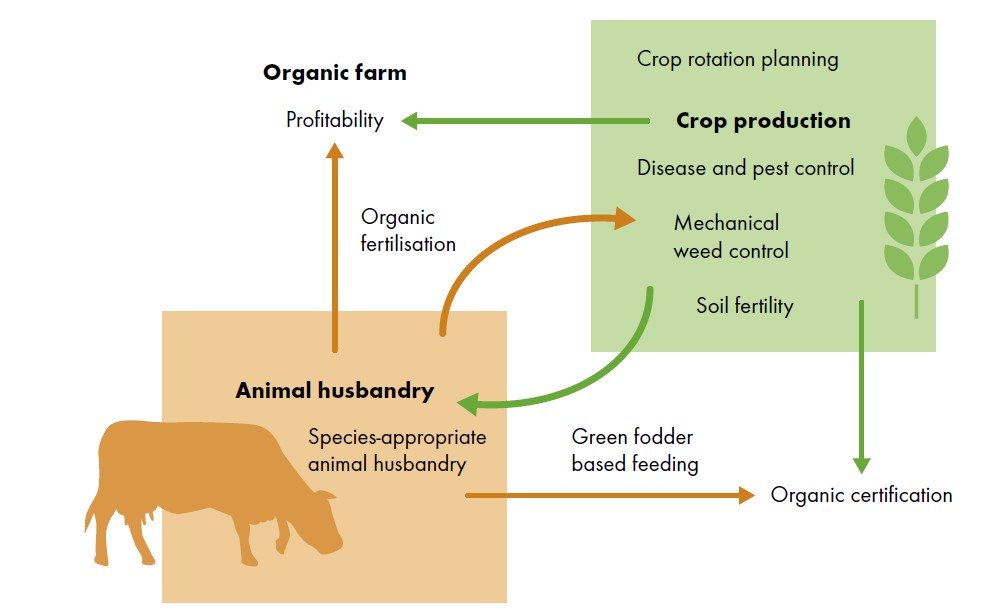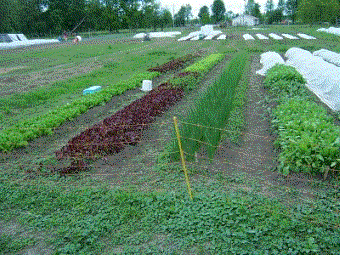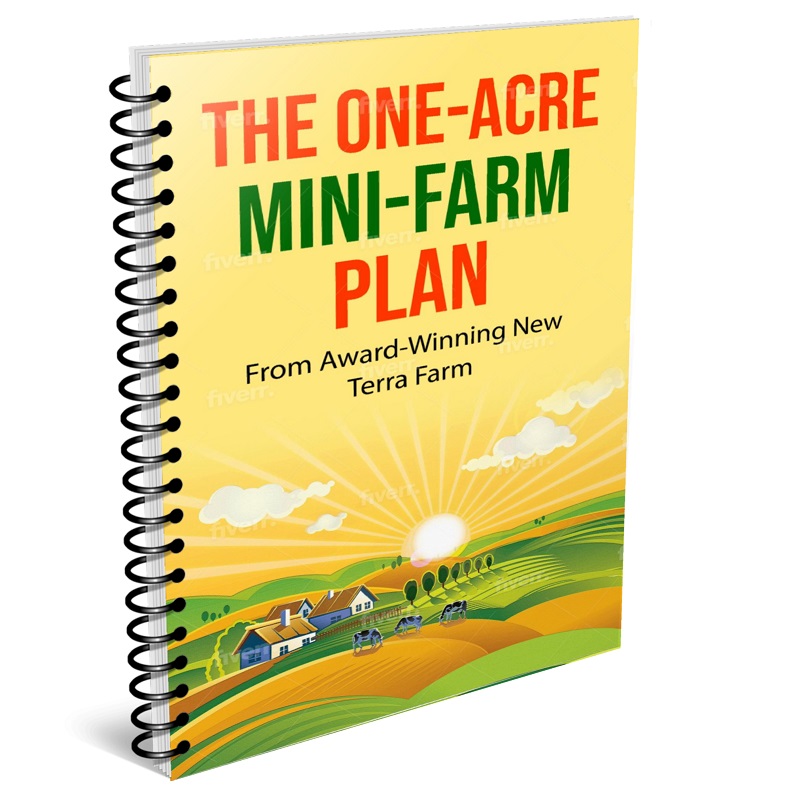What is Micro Farming?
 Crop production and animal husbandry are closely linked on organic farms - Research Institute of Organic Agricultue - FIBL Crop production and animal husbandry are closely linked on organic farms - Research Institute of Organic Agricultue - FIBLFrom a farmer's perspective, I can tell you the answer to the question 'what is micro farming' is about more than just the size of the farm. I like to use the acronym MICRO - Many Integrated Crops Raised Organically. That captures much of the real meaning of the term. Micro farming is a method of farming that involves using small plots of land to grow crops efficiently. It's based on the idea of maximizing productivity on a limited amount of space, by using intensive planting methods, crop rotation, companion planting, and other sustainable farming practices. In the picture below you can see our 'micro farm'. Although we actually own a bigger plot of land, our farming activity was conducted on about 2 acres. This included raising pastured pork and poultry and rotating them through our one acre garden site. There are good reasons to include small livestock in your micro farm plans. See more about that below.  The main garden at New Terra Farm just over one acre The main garden at New Terra Farm just over one acreWhat is Micro Farming's Appeal?
There are several reasons why micro farming is becoming more popular. Besides the opportunity to earn extra income by selling their produce at local farmers' markets or through Community Supported Agriculture, you reduce your reliance on grocery stores.  Get my FREE One-Acre Farm Plan and learn how to raise pigs, chickens and more, integrated with an organic market garden, to make more money from your small property. Imagine building a profitable and sustainable mini-farm even on a small piece of land. Enter your best email and the Guide will be sent to you right away. Control: Your micro farm allow you to have greater control over what you eat and how it is produced, enabling you to customize your diet to suit your needs and preferences. Environmentally friendly: The fact that micro farmers use techniques like composting, cover cropping, and natural pest control to maintain healthy soil and minimize the use of synthetic fertilizers and pesticides appeals to growers and customers. This makes micro farming a great option for people who are concerned about the environment and want to support sustainable agriculture. Connect with community: My own experience at New Terra Farm suggests micro farming is also a great way to build community and connect with other farmers and gardeners in your area. When we sold at the Merrickville Market we met other growers and consumers who are passionate about sustainable agriculture. This creates a sense of camaraderie and support that makes micro farming a psychically rewarding activity as well as financially rewarding. A great side hustle: Micro farming can be done on a part-time basis, which makes it a great option for people who want to supplement their income while still working another job. See more at this page Backyard Garden Profits. Bring your kids in: Micro farming can be a great way to teach kids about where their food comes from and the importance of sustainable agriculture. Low cost start-up: Micro farming requires some basic equipment, such as hand tools and a small tractor, but it doesn't require a huge investment in expensive machinery. Outdoor Exercise: Micro farming is a great way to get outside, enjoy the fresh air, and get some exercise in a natural setting. Why you MUST Consider Raising Small Livestock on Your Micro Farm
Integrating livestock into your micro farm can bring several benefits, including: Soil Fertility: Livestock can contribute to soil fertility through their manure, which is rich in nitrogen, phosphorus, and other nutrients essential for plant growth. This can reduce the need for synthetic fertilizers, saving money and reducing environmental impact. Crop Rotation: Integrating livestock into a micro farm can also take your crop rotation, which helps to improve soil health and reduce pest and disease pressure, to the next level. Weed Control: Livestock can also help to control weeds by grazing on them, reducing the need for herbicides. Diversification: Integrating livestock into a farm can also help to diversify the farm's income streams. Naturally raised pork, chicken and eggs are popular with customers. How to Get Started with Micro FarmingGetting started with micro farming is a lot like starting any other farm business. There is a right way to go about launching your business that will enhance your chances for success. YOU can see more on my Bootstrap Market Gardening page, but essentially the right order of tasks is Planning => Marketing=> Management=> Production. In other words you need to: 1. Set some targets and goals for your micro farm, 2. Figure out how and to whom you will sell your farm goodies, 3. Set up the processes to grow what your hungry customers want, 4. Work your plan to grow your crops over the whole season. Resources and RecommendationsSave 15% on a selection of farm and garden supplies. Read my Garvee review here More farm-grown reviews of products for the small grower and homesteader Grow for maximum profit Grow the Top Ten Most Profitable Vegetables CSA farms have the highest net income of all market garden models. Bootstrap Market Gardening shows you how to launch one of your own. Step-by-step guides and Bonus Tools to build a sustainable, profitable business even on a small property. Bootstrap Book series.
|
See Something You Like? Share!
Got questions to ask, stories to tell?
Share your organic market gardening question, or comment, or story.
Recent Articles
-
Farm grown reviews of products recommended by New Terra Farm
Dec 04, 25 06:26 AM
Find great farm and garden products in my farm grown reviews -
Best Chicken Coop and Accessories for Small Farms and Homesteads
Nov 30, 25 09:18 AM
Looking for the best chicken coop? Here are the top coops, accessories, nest boxes, and gear to build a safe, productive poultry setup. -
Community Supported Agriculture Marketing Ideas To Sell Out The Season
Nov 05, 25 05:18 AM
Authentic Community Supported Agriculture marketing ideas to grow loyalty, boost sign-ups, and sell out your CSA every year



